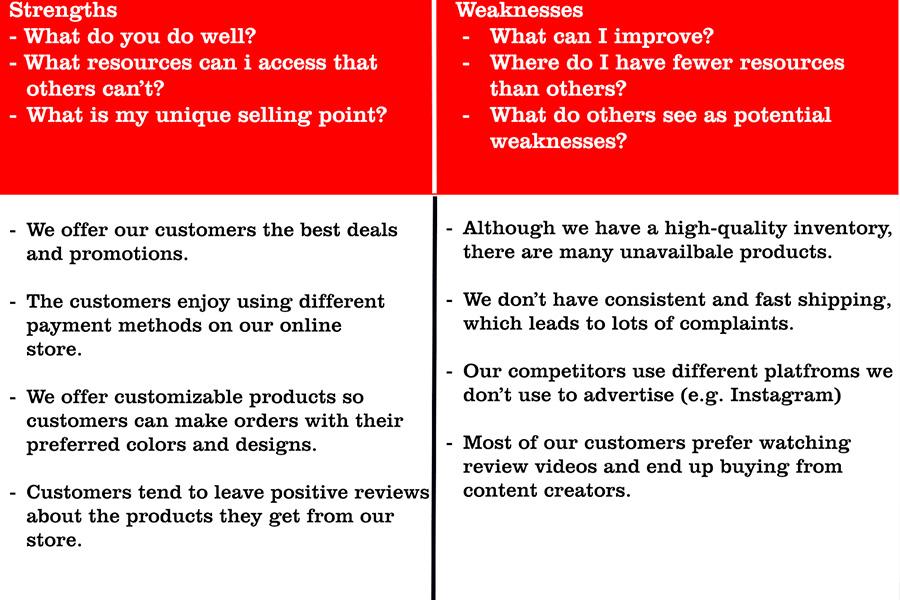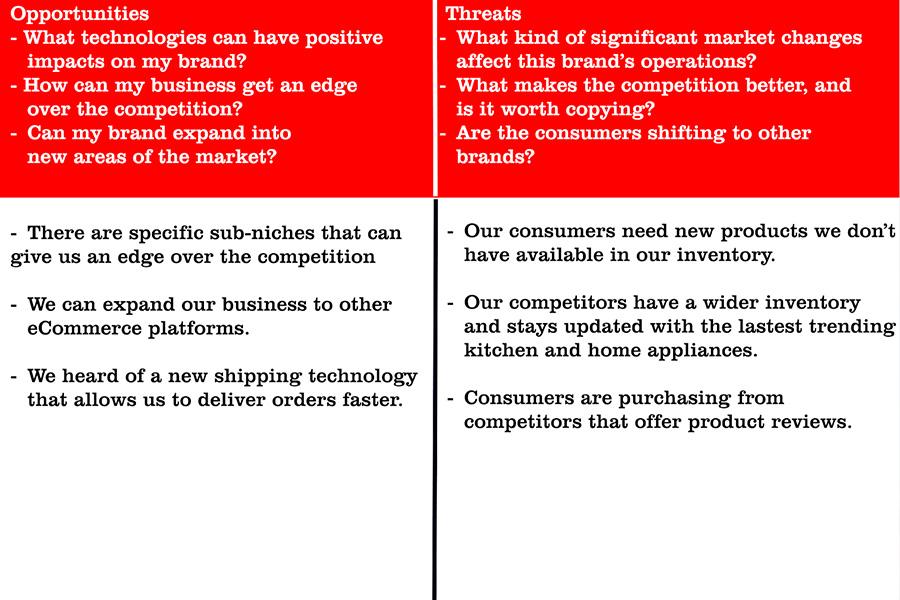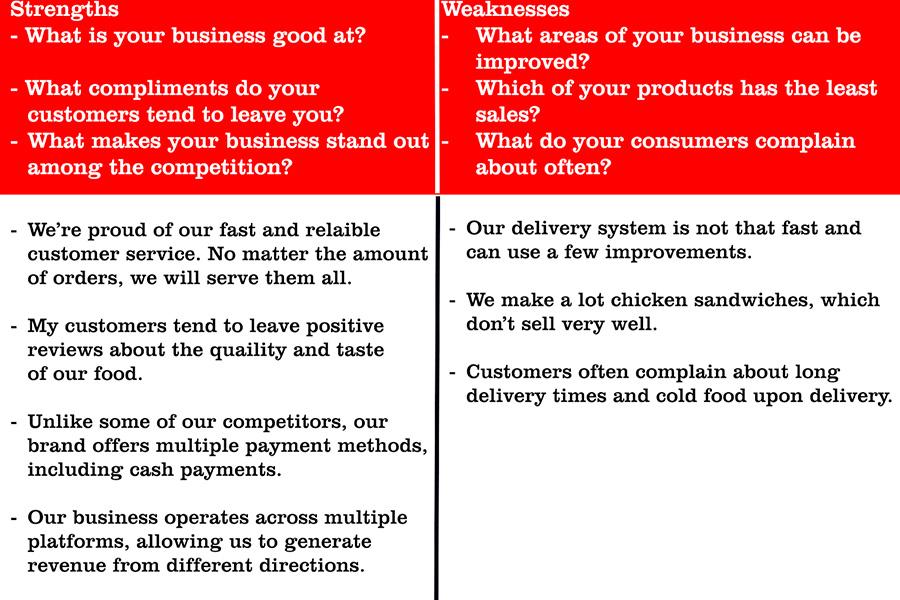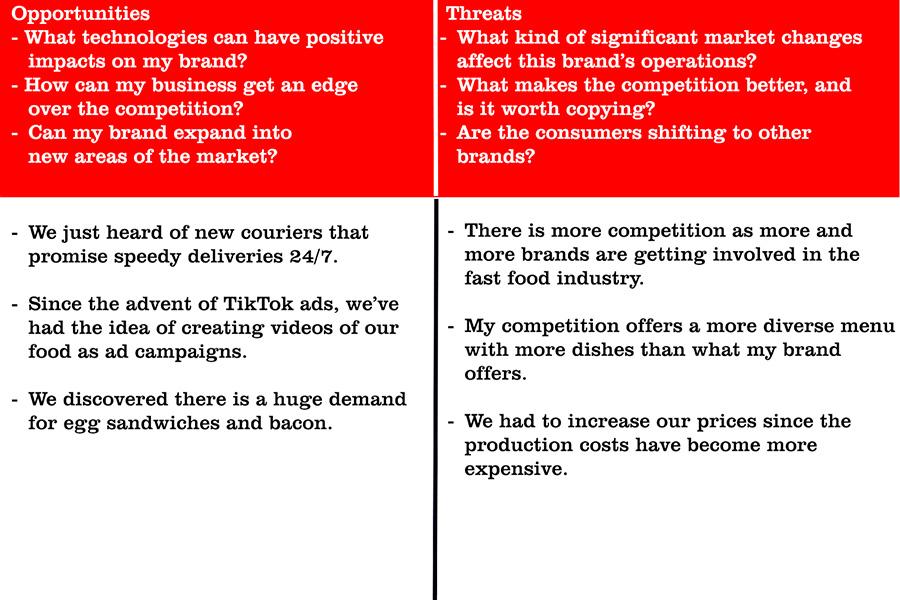For a business to experience steady growth, analysts need to regularly monitor and adapt the company’s strategy—at least once in a business year cycle. And that’s where deploying a SWOT analysis can be particularly useful. It’s an analytics tool that encompases the essential factors affecting a company’s present and future growth.
Given the value of SWOT analysis in steering business strategy, this article will offer an easy to follow guide on how to conduct a practical SWOT analysis, and how to use the results of such an analysis to further optimize one’s strategy.
Table of Contents
Why should businesses conduct a SWOT analysis?
How and when should businesses conduct a SWOT analysis?
Real-life eCommerce SWOT examples
SWOT analysis tips and tricks
Final Words
Why should businesses conduct a SWOT analysis?

With a SWOT analysis, businesses can eliminate guesswork and understand the best steps to take at each stage of their operations—while creating better strategies for the future. A SWOT analysis can also be used to identify and weed out weak or low profit areas of the business.
A good SWOT analysis examines the internal and external factors that can impact a business, creating a holistic view of the scope of its operations. By doing so, retailers can discover key points of leverage, as well as pinpointing the uncontrollable risks that the business faces.
For example, if a business plans to expand its reach to a different location, a good SWOT analysis can help determine if the business is ready for expansion or not.
Additionally, sellers can develop more precise responses to the data they discover, analyze, and record through SWOT analysis. They can even protect themselves from competition and other threats that may affect the business.
How and when should businesses do a SWOT analysis?
Businesses need more than one point of view to understand how they can run their organization. Relying solely on the manager or CEO’s opinion isn’t necessarily the best option. So, they can seek opinions from different levels of the organization—not forgetting customer reviews as well.
To get something productive out of a SWOT analysis, the company should assign at least one rep from each department, and a team lead to ask the key questions. This can be done with a whiteboard and some sticky notes to write down the answers to the questions asked by the team lead—while grouping them based on their SWOT.
Here are steps to take:
What are the strengths of the business?
Whatever a brand does exceptionally well is considered its strength or unique selling point (USP), allowing consumers to distinguish them from the competition. For example, it could be access to specific materials or a different manufacturing process. Furthermore, brands can brainstorm on their competitors’ advantages, seeking the key factors that allow them to generate more sales.
With that blueprint in mind, a business can identify its strengths by asking these few questions:
- What does our brand do better than others?
- What are the values of this company?
- What resources can this organization use that others can’t access?
- And finally, what is this organization’s USP?
Brands can add the answers they get from these questions to the strengths section. In addition, the team lead can choose to add more questions—with the help of past customer queries or challenges faced in the past.
Are there weaknesses?
Similar to strengths, weaknesses can show up in various forms and sections in a business.
So, in this section, brands should brainstorm on the key areas that require fixing or improvements, as well as the possible practices they can avoid.
They can start by asking the following questions:
- What are the company’s most underperforming department(s) or segment(s)?
- Does any team in the company lack the technical know-how and capabilities to perform effectively?
- What are we lacking that our competitors have (resources, assets, etc.)?
- What do our competitors see as our company’s primary weakness?
Finding actual weaknesses requires honesty and realism. As a result, brands must be ready to handle the harsh truths and not be averse to listing them as official weaknesses. This is done with the goal of making improvements in the long run.
What opportunities are available?
In business, opportunities are windows of possibilities—produced from random external chance. And so while businesses can’t always predict an opportunity, they should do their best to be ready to go for them—that is, when they do show up.
Opportunities can come from market developments or technological advancements. A brand’s ability to recognize and utilize these opportunities can shoot them ahead of the competition, making them market leaders.
Retailers can consider different opportunities they feel may be worth taking. Remember that even the slightest change can make a huge difference.
Here are some key questions brands can ask to identify opportunities:
- What are the current trends revving up the company’s industry?
- What technologies can have positive impacts on this brand?
- How can this business get an edge over the competition?
- Are there incoming events or government policies that the business could benefit from?
- Can the business resources and assets be leveraged to get better results?
- Can this brand expand into new areas of the market?
Are there any threats?
As the opposite of opportunities, threats comprise external factors that can negatively impact a business. So, brands must always try to foresee threats and develop counters to avoid them—or they can lead to stunted growth.
Retailers should also check how exposed they are to obstacles from outside the organization. Sometimes, it could be a heavy debt or tricky issues with the company’s cash flow.
Additionally, businesses must remember that their competitors are constant threats—whether they know it or not. Thus, they should observe the moves of their competitors closely and know when to make a few changes. But, they should avoid blindly copying the competitor—without a clear and mapped out idea of how it can improve their brand.
Businesses also need to consider the challenges that can affect their market. The slightest change in social patterns can be a threat, especially if it gives the competition an edge. Bear in mind that some potential opportunities may be threats in disguise and may be difficult to spot early.
For example, many consumers and manufacturers thought that electric-vehicle cars threatened the regular gas-powered cars when Elon Musk’s Telsa motors took the front row. But today, things are evolving, and more conventional vehicle companies like GM, Ford, and Toyota are fast adopting electric-powered engines into their cars.
Thus, business teams need to keep an eye out and be very cautious to identify and avoid threats that may look like opportunities. Experience also has a role to play in such scenarios.
With that in mind, here are some vital questions team leads can ask when brainstorming:
- What significant market changes can affect the brand’s operations?
- Can this affected area drain the organization’s profits?
- What makes the competition better, and is it worth copying?
- Are there new competitors entering the market?
- Is the industry currently facing a recession or is it volatile?
- Are the consumers’ needs or behaviors changing?
When should businesses perform SWOT analysis?
Brands should perform SWOT analysis when launching a new product, taking a new company action, or changing a plan during execution. A SWOT analysis will also come in handy when brands want to explore new opportunities or change internal policies.
Real-life eCommerce SWOT examples
Here are some real-life examples with ideas that helped a few brands run solid SWOT analyses in the past.
1. Kamgot’s appliances
The first example is a brand that sells different kitchen and home appliances. Here are a few points in a SWOT framework showing where Kamgot is lacking and what they can improve:


The key takeaways from this SWOT analysis include:
- Most customers prefer watching review videos, and they make purchases from these video channels. Kamgot can create a YouTube channel to upload product reviews and link them to their online store.
- Kamgot’s inventory seems to lack many new-model products, even though they have a high-quality stock. Therefore, they can examine their inventory and add new products to meet consumers’ demands.
- Kamgot has the opportunity to expand its reach to multiple eCommerce platforms. They can also engage in different sub-niches to gain an edge over their competitors.
2. Erelish fast foods
The second example focuses on an online food vendor that sells different delicacies and drinks. This business runs three online stores on various eCommerce platforms.
How can Erelish fast foods do better and compete in the online fast food market?
The following SWOT analysis can provide some insight on that that:


Here are the key findings from Erelish’s SWOT analysis:
- Erelish fast foods faces the massive threat of rising competition and could potentially go out of business. But they have enough experience to leverage positive reviews. They can use these reviews to boost brand credibility and gain trust from new customers.
- It’s more expensive to cook dishes, but there is strong demand for egg sandwiches and bacon. Thus, Erelish fast foods can make more profit by using the opportunity to sell these products that offer a higher profit margin.
- This food brand has many positive reviews and great ideas for creating food videos. These can easily amplify the brand’s message of offering quality food with excellent taste.
SWOT analysis tips and tricks
Prepare ahead for threats and opportunities
It’s good business practice for brands to stay prepared. Opportunities and threats can arise anytime, making it essential to stay alert. Some new ventures will go as planned, while others may lead to disappointment. As a result, one should always be prepared and keep a keen lookout for changes that can affect one’s operations.
Create opportunities from the weaknesses and strengths
Brands should never accept their weaknesses and strengths as natural phenomena. Rather, with market research and continual improvements and adjustments, businesses can transform their strengths and weaknesses into profitable opportunities.
Rely on data to get a complete picture
Businesses need more than one perspective to get the whole idea. Unfortunately, an individual perspective, whether from a CEO or manager, can have several blind spots. But a SWOT analysis run with representatives from various departments can help uncover these blind spots and allow brands to create more effective business plans. And as far as possible, the points in the SWOT analysis should be backed up by insights from data.
Also remember that credibility is key when getting data for analysis. So businesses can get data from credible online sources like “.gov” websites, online trust-worthy research websites like Statista.com, customer review forms from the customer support team, customer complaints both internally and externally within the industry, and even via a deep survey of Google search engine results. Another way to get quality data is by sending questionnaires to already paying customers.
Actionable steps to take after running a SWOT analysis
Completing a SWOT analysis is not the end of the process. There are some actions brands need to take after getting data from a SWOT analysis. Here are four of actionable steps they can follow:
Step1: Find strategic options
The first thing brands need to do after completing a SWOT analysis is to take a record of the various factors impacting the business. Factors under the strengths and weakness section are internal, while those under opportunities and threats are external.
Brands can identify strategic options after sorting out the factors influencing their business plan. What they need to do here is pair elements from different sections to create a strategy.
For instance, if a brand’s strength is excellent reviews, they can pair that up with the opportunity to sell products in high demand.
At this point, retailers can create an action item based on the developed strategy. For example, an action item would be uploading advertisements that ride the brand’s positive reputation. Then, retailers repeat the process—until they have evaluated and paired all the factors in their SWOT sections.
Step 2: Prioritization
Some strategic options must have higher priorities for businesses to efficiently use their resources. Therefore, when a business identifies a set of strategic options from step one, key stakeholders should have a meeting to discuss them.
Such meetings can help determine what strategies businesses should focus on first, as well as which options may require the most resources. This step is key to leveraging the business’s strengths to drive its profits.
Step 3: Balancing priorities

Next, retailers need to balance their priorities into the four categorical perspectives, including:
- People/cultural excellence
- Market growth
- Operational excellence
- Financials
Based on the previous example of advertising high demand products to boost profits, such a program would fall under the “financials” categorical perspective.
Step 4: Create an actionable roadmap
Roadmaps help businesses to bring their plans to life. It also allows brands to set timeframes and milestones for achieving their goals.
Brands therefore need to choose significant elements for their roadmap, each with specific steps that can ensure they are achievable. They’d need to divide their strategic options into long-term strategic objectives, one-year goals, and targets/objectives. Businesses will have a complete, actionable plan after completing the roadmap.
Final Words
Brands can use a SWOT analysis to discover blind spots, avoid threats, and grab opportunities as they come. Conducted one or twice a year SWOT analyses allow brands to draw from a varied perspective, and to stay up-to-date with the key changes in their market sectors. Also, businesses can use the SWOT analysis data to create actionable plans, resolve their weaknesses, and counter external threats.
With that in mind, this guide has covered a step-by-step approach to conducting a SWOT analysis, so that businesses can use this technique to optimize their operations and leverage their key strengths.




